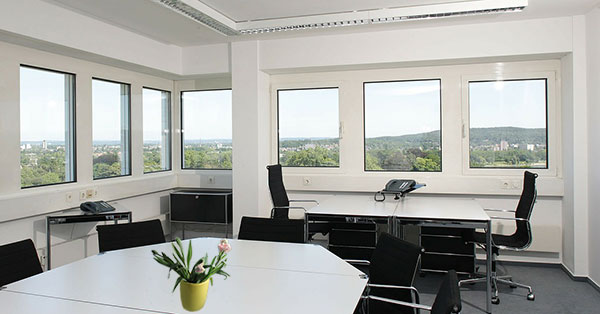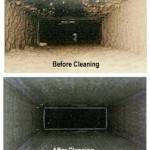
In today’s heavily industrialized world, people can rarely afford the luxury of breathing fresh forest or mountain air. A quick escape to nature is usually only possible on weekends and holidays but at all other times, it is the polluted environment of the big cities that we have to endure. However, even in urban centers, the concentration of air pollutants is about 4 times less outdoors than indoors.
Poor indoor air quality is caused by a wide variety of factors, but it is the reduced air exchange rates inside buildings that allow air contaminants to build up to dangerously high concentrations. In fact, the quality of indoor air can seriously affect the health, comfort, and productivity of the building occupants, so as a business owner, you need to make every effort to provide your customers and employees with a healthy and pleasant working environment.
Indoor Air Quality Facts
Reportedly, US citizens spend about 90% of their time indoors. That’s the reason why indoor air quality has such a great impact on public health and worker productivity.
Types of Air Pollutants
The most common indoor air pollutants include naturally occurring irritants, such as dust mites, mold spores, bacteria, and pet dander, and harmful chemicals that are released from cleaners, textiles, and building materials. Tobacco smoke, radioactive gases, and various fumes also float through the air in a commercial building, compromising its quality and resulting in infections, allergy symptoms, and other health risks.
Sources of Indoor Air Pollution
Potential sources of air contaminants in office buildings include but are not limited to:

- Dust and dirt tracked inside on people’s clothes and shoes;
- Cleaning chemicals that contain toxic vapors and/or volatile organic compounds;
- Pesticides;
- Deodorizers and cosmetics;
- Tobacco smoke;
- Office equipment such as copy machines and printers;
- Stagnant water, damp materials, or moist areas;
- Furnishings;
- Building materials.
When concentrations become excessive, building occupants start experiencing allergy symptoms and general discomfort. Unless timely and efficient measures are taken to improve the quality of the air in the premises, different health problems may gradually develop.
Effects of Poor Indoor Air Quality
The most common symptoms of poor indoor air quality are similar to the symptoms of other health problems such as allergies, stress, colds or influenza:
- Irritation of the eyes, nose, throat, and skin
- Headaches
- Coughing and/or sneezing
- Fatigue
- Dizziness
- Shortness of breath
- Hypersensitivity
- Nasal congestion
Prolonged exposure to very high levels of air contaminant concentration or the presence of particularly harmful air pollutants in your working environment may result in more severe problems:
- Respiratory diseases and difficult or painful breathing
- Exacerbated asthma
- Rapid heartbeat and heart disease

Poor indoor air quality may result in various health problems. - Nausea and vomiting
- Lethargy or malaise
- Lung cancer
Different people react to poor air quality in different ways depending on their sensitivity and overall health condition, as well as on the amount and the type of air pollutants in their working environment. However, the longer a person breathes polluted air, the more frequent his/her health complaints will become. To prevent serious health hazards and reduce employee sick days, you need to find quick and efficient ways to improve the air quality in your office or commercial building. What’s more, better office air quality will not only significantly reduce workplace sickness and the cost of sick leave to the organization, but will also help reduce stress levels and increase workers’ concentration and productivity.
How to Improve Indoor Air Quality in Office
Whatever particular steps you take to improve office air quality, they should aim at either reducing and removing the sources of indoor pollution, or reducing the concentration of indoor pollutants through ventilation and cleaning.
So, how can you improve the indoor air quality in your office?
1) Improve ventilation. Unless there is enough fresh air flowing through your office to reduce contaminant concentrations, poor IAQ may easily develop. Good air circulation is essential for preventing the buildup of indoor air pollutants. So, you need to allow more fresh air inside and let it circulate freely within the premises – increase ventilation through windows and doors and install exhaust fans throughout the building (especially in bathrooms and other moist areas);
2) Keep temperature and humidity in the building at an optimal level. High temperature and humidity levels can also contribute to the increased concentration of indoor air pollutants. Mold spores, different fungi and bacteria, as well as many other allergens thrive in warm and moist places, so you need to find an effective way to reduce moisture in indoor air and lower the concentration of air contaminants. Keeping humidity levels at around 30%-50% will help control allergens and improve the quality of the air. Proper air conditioning provides the easiest and most efficient way to maintain a healthy indoor environment (of course, you need to take care of any sources of excess moisture in your property first – fix leaky plumbing, remove stagnant water, clean up spills as soon as they occur, etc.) Using quality dehumidifiers is also a good idea;

3) Maintain the HVAC system. The HVAC system not only helps control contaminants, but also provides a comfortable working environment. Many IAQ complaints originate when the HVAC system is malfunctioning and/or fails to meet the occupants’ comfort needs – either by not adequately controlling temperature and humidity levels in the premises or by not delivering enough outside air. Proper HVAC maintenance includes the regular cleaning and changing of air filters. Air filtration is essential for ensuring a healthy indoor environment, as it helps clean the air circulating through your building. While air filters can’t control microorganisms like mold spores and bacteria (you need UV light installations in the HVAC ductwork to inhibit such harmful microorganisms), they effectively capture airborne particulates and debris and may even help control odors;
4) Invest in regular air duct cleaning. Large amounts of air pollutants accumulate in the air ducts, so their regular and thorough cleaning is of paramount importance for preventing the buildup of contaminants and keeping the air that circulates through your building fresh and healthy. Air duct cleaning, however, is a difficult and laborious task that is better left to the professionals. Air duct cleaning specialists have the specialized equipment and rich experience required to complete the job in a quick and efficient manner and ensure the good quality of the air in your office;
5) Maintain perfect cleanliness. Keeping your surroundings spotless is essential for improving indoor air quality. Chemicals and allergens can easily accumulate to large amounts on the floors and other surfaces in your office. To reduce the concentrations of contaminants in your working environment and get rid of toxins, pollen, pet dander, dust mites, and other allergens, you need to clean the premises on a regular basis. Use a vacuum cleaner that has strong suction, rotating brushes, and a HEPA filter to make sure that dust and dirt won’t get blown back into the air. Clean high traffic areas daily and vacuum the same spot several times. Be very careful when vacuuming carpet edges and upholstered furniture, where dust accumulates in larger quantities and don’t forget to wash out the vacuum filter regularly. Mop or wet wipe all the surfaces in your office to pick up dust and any other lingering allergens. You are recommended to use the new microfiber mops and dust cloths that capture more particles than traditional fibers and don’t require any cleaning solutions;

6) Avoid cleaners and other products that contain harmful chemicals. Harsh cleaners that use chlorine or ammonia, as well as most solvents and disinfectants, contain toxic vapors and/or volatile organic compounds that pollute the air and may provoke allergic symptoms or trigger asthma Many common products such as paints, varnishes, and glues also give off harmful fumes and VOCs. Therefore, you are strongly advised to use as few chemicals as possible in your office and to air the premises thoroughly if any of the above-mentioned products have been used.
Special Note: Never store chemicals in areas occupied by people and make sure you dispose of any expiring products in a timely and adequate manner!
7) Prohibit smoking in the building. Secondhand cigarette smoke is considered to be the most common and most harmful indoor air pollutant. It contains more than 4000 chemicals (including formaldehyde and carbon monoxide) that can cause pneumonia, lower respiratory tract infections, asthma attacks, ear infections, heart diseases, lung cancer, etc. Secondhand smoke cannot dissipate indoors and builds up over time, so smoking should not be permitted indoors or within several feet of a building entrance;
8) Extra tips for improving the indoor air quality in office:
- Forego air fresheners – most plug-in fresheners, aerosol sprays, and other scented products emit harmful volatile organic compounds;
- Avoid pesticides – try innovative pest control methods that do not require the application of pesticides (major sources of air pollution);
- Introduce indoor plants – plants help regulate the humidity levels in the premises and purify the air;
- Invest in indoor air quality testing – some dangerous indoor air pollutants are very difficult to detect (such as radon, for example – a colorless, odorless gas that is the second leading cause of lung cancer in the USA). So, it is a good idea to perform a test for air contaminants (VOCs, formaldehyde, radon, lead, etc.) in your office and know for sure if the working environment is safe and healthy. Consider hiring professionals for more accurate testing and evaluations of the air quality in larger buildings;

Many of the most efficient ways to improve the air quality in your office are quite simple and inexpensive – indoor plants, good ventilation, regular cleaning, etc. - Keep dust and dirt out – place large doormats at every entrance to your building to prevent dirt, dust, pet dander, pollen, and other pollutants from being tracked inside on people’s shoes;
- Use air purifiers – stand-alone air purifiers are not powerful enough to improve the overall air quality in your building but they can still help eliminate dust, pollen, dander, mold spores and other particles that are floating around in your office;
- Infuse indoor air with essential oils containing antibacterial or purification properties;
- Keep large copy machines and other major emission sources in a separate room.
Oftentimes some simple and inexpensive measures (good ventilation, regular cleaning, proper building maintenance, etc.) can help greatly improve the indoor air quality in your office and ensure the well-being and the higher productivity of your employees. All you need to do is understand the importance of having a healthy working environment and take the necessary steps to achieve it.






